Cards In This Set
| Front | Back |
|
Atretic Follicle
|
A degenerating ovarian follicle in mammals. Atresia may appear at any stage of follicular growth, destroying the oocyte, follicle cells, and the theca; in some species (cat) stresia involves dispersal of some follicle cells, which then form interstitial cells.
|
|
Atresia
|
Atresia is a condition in which a body orifice or passage in the body is abnormally closed or absent.
Examples of atresia include:
|
|
Follicular atresia
|
Follicular atresia is the break-down of the ovarian follicles. It occurs continually throughout a woman's life, as she is born with approximately 2 000 000 follicles and will only ovulate around 500 in her lifetime.
The granulosa cells stop growing and detach from the basal lamina. The oocyte dies and the whole unit is phagocytosed.
Theca interna cells may persist and secrete androgens, at which point they are known as interstitial cells, which are active from childbirth until menopause.
|
|
Corpus luteum
|
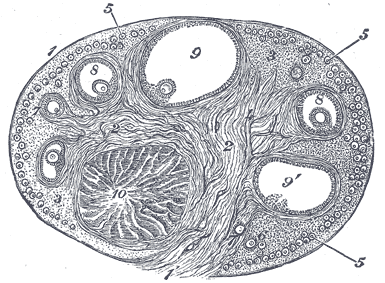 A mass of endocrine gland tissue in the ovary of viviparous (live young, not eggs) vertebrates; forms from an ovulated follicle and persists into pregnancy; secrets progesterone. The corpus luteum (Latin for "yellow body") (plural corpora lutea) is a temporary endocrine structure in mammals, involved in production of progestogen, which is needed to maintain the endometrium. |
|
Cortex
|
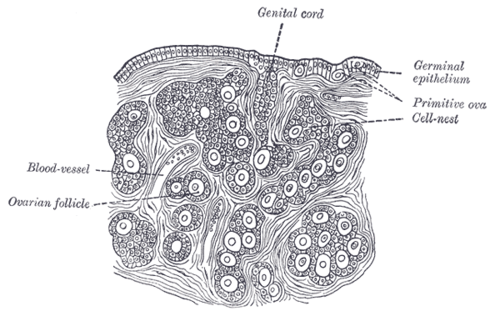 The outer zone of an organ or egg; contains the follicles and corpora lutea of the ovary |
|
Cumulus Oophorus
|
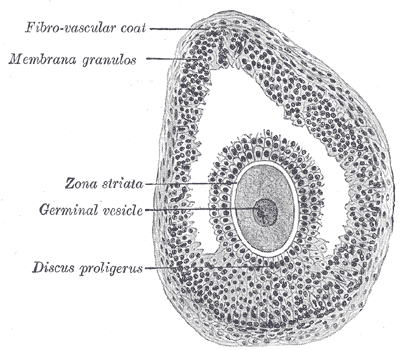 A thickening in the stratum granulosa containing the mammalian oocyte At one part of the mature follicle, the cells of the membrana granulosa are collected into a mass which projects into the cavity of the follicle. This cluster of cells is termed the cumulus oophorus (Latin cumulus=heap, Greek oo=egg + phorus=carrying) discus proligerus, and it is released with the embedded oocyte during ovulation. In order for fertilization to occur this layer must be penetrated by the spermatocyte |
|
Diplotene Stage
|
A stage of the first meiotic division in spermatogenesis and oogenesis; follows the pachytene stage; chromosomes in synapsis separate exept at points of crossing over (chiasmata); followed by diakinesis.
During the diplotene stage, also known as diplonema, from Greek words meaning "two threads", the synaptonemal complex degrades and homologous chromosomes separate from one another a little. The chromosomes themselves uncoil a bit, allowing some transcription of DNA. However, the homologous chromosomes of each bivalent remain tightly bound at chiasmata, the regions where crossing-over occurred. The chiasmata remain on the chromosomes until they are severed in Anaphase I.
|
|
Diakinesis
|
Meiotic stage during which the chromosomes separate farther moving the chiasmata to the ends of chromosomes (terminalization); metaphase of the first meiotic divisions follows diakinesis.
Chromosomes condense further during the diakinesis stage, from Greek words meaning "moving through".This is the first point in meiosis where the four parts of the tetrads are actually visible. Sites of crossing over entangle together, effectively overlapping, making chiasmata clearly visible.
|
|
Egg Pronucleus
|
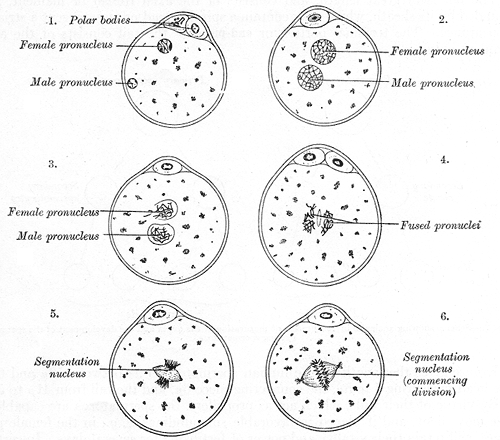 The haploid nucleus of the mature egg formed by the competion of the second meiotic divison. A pronucleus (plural: pronuclei) is the nucleus of a sperm or an egg cell during the process of fertilization, after the sperm enters the ovum, but before they fuse. Sperm and egg cells are haploid, meaning they carry half the number of chromosomes. When the pronucleus of a sperm fuses with the pronucleus of an egg, their chromosomes combine and become part of a single diploid nucleus in the resulting embryo, containing a full set of chromosomes. |
|
Follicle Cells
|
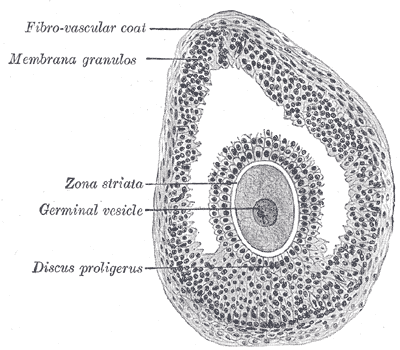 The epithelial cells enclosing the oocyte; probably regulate the transfer of material to the oocyte; form the stratum granulosa of bird and mammalian follicles. |
|
Follicular Cavity
|
The space within the Graafian follicle; filled with a viscous follicular fluid
|
|
Germinal Epithelium
|
The epithelial covering of the adult ovary and the embryonic gonad; derived from splanchnic mesoderm and primordial germ cells
The surface of the ovary is covered by a layer of simple cuboidal cells which constitutes the germinal epithelium
The germinal epithelium gives rise to primary follicles and is the main origin of tumors in the ovaries
The germinal epithelium is the innermost layer of the testicle.
|
|
Germinal vesicle
|
The much enlarged nucleus of the oocyte; during the prophase of the first meiotic division; its membrane breaks, releasing most of its contents into the cytoplasm.
|
|
Graafian follicle
|
The ovarian follicle of mammals containing a follicular cavity; derived from a primary follicle and either atrphies (atresia) or ovulates to form a corpus luteum
|
|
Interstitial cells
|
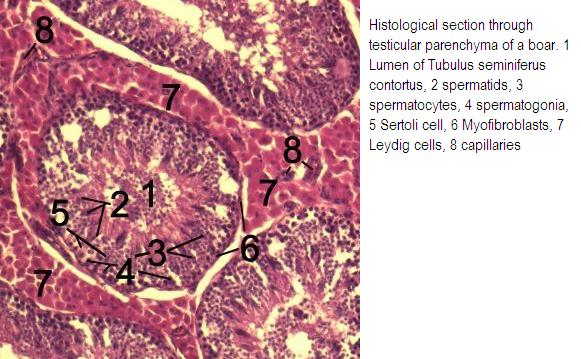 In the testis, clusters of endocrine gland cells (Leydig cells) between the seminiferous tubules which secrete testosterone; in the ovary, clusters of glad cells scattered in the cortex; derived from arteric follicles |



